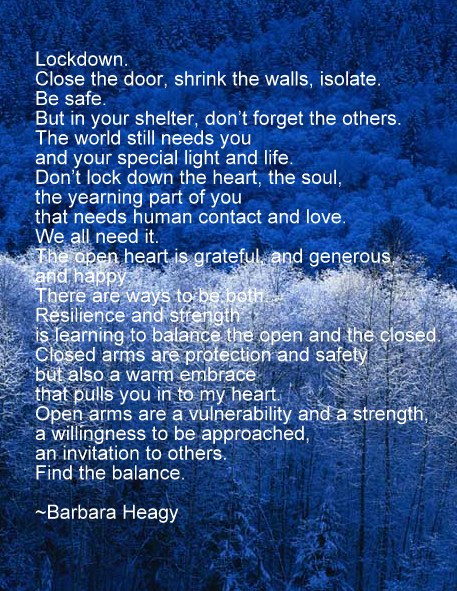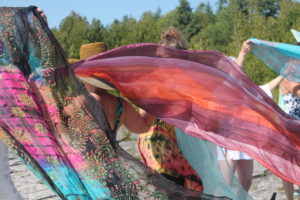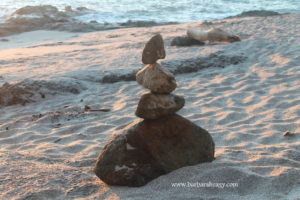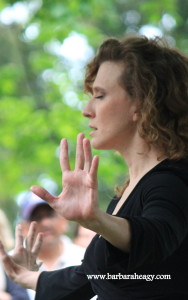
Tag: balance in life
Tradition
“Because of our traditions, we have kept our balance for many, many years.”
~ Teyve – Fiddler on the Roof
This weekend some of my Christmas traditions kicked in, helping to ignite my Christmas spirit.
I attended the Toonie Turkey Supper at St. John’s Anglican Church, Orangeville, where friends from the past gathered to enjoy a delicious turkey dinner with all the trimmings — a night meant to celebrate community and promote fellowship.
That same night, my family went downtown to celebrate the seasonal Tractor Parade of Lights. It was fun to be so close to the roaring tractors and big farm machinery and rigs all lit up with twinkling, colourful lights.
The next morning, we took the grandchildren to the annual Candy Cane Fair at the local hospital. For $2, the grandchildren were escorted away by an elf to choose and wrap a small gift for their mom, dad, grandma, or grandpa. This event is meant to help children get into the spirit of gift-giving during the holiday season and raise some funds for hospital equipment. Santa was there with Mrs. Claus for picture taking and there were craft tables and raffle tickets.
We went home again but only for a short while before we headed downtown again for the annual Santa Claus Parade with its colourful floats, marching bands and community participation.
Traditions are important. They give us a sense of belonging and add a secure rhythm to the seasons. They bring family and community together to enrich our lives and create memories. Through traditions, we reconnect with each other, find balance in our lives, and a little bit of magic.
What are some of your traditions?
I Am From
As an introduction to each other at our recent Rhythmwood Soul Journey, Wendy Roman asked us to write a poem about ourselves from a basic form called “I Am From . . . “. All we had to do was fill in the blanks as we reminisced about our past and contemplated all the people and events that had formed who we are today. Here is my poem. What would your poem be?
I Am From by Barbara Heagy
I am from country farms,
From czardas and paprikash.
I am from grandma’s warm lap
like sheltering laughter.
I am from lilacs, fresh mown hay,
and bubbling creeks.
I am from hippies and hash,
From cool northern lakes and jumping fish.
I am from journals and contemplations,
From words and books and songs.
I am from breath and moving bodies.
I am from spiritual journeys danced in prayers,
laced with pain and grace.
I am from daughters to grandsons.
I am from love –
assured and unconditional.
A Balancing Act
Have you ever watched someone actually creating those wonderful balanced rock structures? You know the ones where they take a small stone and magically, or so it seems, balance another bigger rock on top of it, and then another, and another, until they hold together in one big delicate balance. They amaze me. I’ve tried it myself to no avail. I can’t even get two stones to balance, nevertheless, three, four or more.
This morning, catching up on my morning Facebook, I came across a friend’s posting of one of these incredible rock artists. I learned something watching the video, something I had never noticed before.
I’ve always thought that the structure was built one stone at a time, fully balancing the first one before the second, and then the third was added. But I noticed that the artist didn’t build them one at a time, fully balancing one before he balanced the others. He worked with the group, holding them together with his hands, as he built. If he let go too soon, before the final stone was put in place, the whole structure would fall. If he kept the group together long enough by holding them all with his hands, the final stone was often the one that put enough pressure on them all to hold the whole structure together. Each stone didn’t stand alone. Each one was necessary and stood on the shoulders of the one above it simultaneously. The stones worked together, at the same time, to find that precarious balance.
That in itself can be a lesson in life. We think we have to move step-by-step, fully balancing one factor in our lives before we move on to the next when, in reality, we need to include all the elements, holding them together long enough until we can put the final factor in place to bring it all together as a balanced whole.
When we feel that we have to fully achieve one thing before we can move on to the next, this separation of the elements can hurt us. It leads to perfectionism which tends to stifle us, sometimes stopping us in our tracks in our intended progress. If we can’t even get one thing fully working in our lives, we feel we are not ready to move on to the next area of expertise and drop it all together. We give up and refuse to take the challenge. We never feel ready or capable or good enough. It can lead to poor self-esteem.
In reality, we often are balancing many components, multi-tasking, learning as we go, pulling the elements together in a jumble of ideas, until the final conclusion hits us full in the face. Or doesn’t. Sometimes we pull it off but the final structure is held in precarious balance, ready to fall at the slightest outside force. But so what? At least by trying to build something, refusing to give up, believing that more than one factor is at work in our lives at a time, we learn from our mistakes, and continue to move forward.
Years ago, I studied modern dance while getting my first undergraduate degree. After four years of study, I left and went travelling. When I got back, I went and visited my former professor of dance. She told me about a local recreation department that was looking for a teacher to lead a creative movement class for children. I told my teacher there was no way I felt ready to teach anybody about dance. What did I know? She assured me I did know enough, so I gathered up my courage and applied for the job. It was the beginning of a career in dance for me, both teaching and performing.
While at the same university, I met a woman in my dance class who was really just starting out in dance. She had been brought up in a very strict religious family, where dancing was not allowed. She couldn’t even skip properly at the first class. That didn’t stop her from teaching her Inter-Varsity social group everything she learned. Day by day, she learned something, and day-by-day, she took what she learned and taught it to others. Her confidence in herself amazed me. She didn’t feel she had to be fully accomplished to offer her skills to others. She was of the Maya Angelou philosophy, “When you learn, teach. When you get, give.”
The world is a busy, multi-factored, jumble of ideas and experiences. Don’t be afraid to pick up many of them and fearlessly start building your life. It’s all a balance. Make yours beautiful.
The Still Point of the Turning World
This week Wendy Roman, of Rhythmwood Dance Studio, asked her Facebook readers what the phrase “Effortless Effort” means to them through dance. Another reader and dancer, Laine Magidsohn, suggested it be called “Dynamic Ease.” I like both phrases. Both phrases speak of finding that balance between active participation and passive release.
I think ‘Effortless Effort’ and ‘Dynamic Ease’, are both phrases of just stepping aside for a moment to connect with life’s energy force. Letting it flow within, embodying it, giving it room to become one with me and then moving forward together. I don’t just step aside and let it take me over. We work together, side-by-side, internally as one. One body, one flow of energy.
When I was getting my MA in Dance at York University, my thesis centered on finding the relationship between creativity and spirituality. I held a day long workshop of movement and dance, journaling and oral sharing. Later in evaluations of the experience, two of the participants spoke of finding ‘stillness’ in the ‘movement’ while they danced. A paradox. After the event, one of the participants gave me a beautiful hand-made calligraphy copy of an excerpt of T. S. Eliot’s “Four Quartets – Burnt Norton.” For her, his poem spoke of finding “The Still Point of the Turning World” and acted as a metaphor for her experience.
From T. S. Eliot’s “Four Quartets – Burnt Norton”:
“At the still point of the turning world. Neither flesh nor fleshless;
Neither from nor towards; at the still point, there the dance is,
But neither arrest nor movement. And do not call it fixity,
Where past and future are gathered. Neither movement from nor towards,
Neither ascent nor decline. Except for the point, the still point,
There would be no dance, and there is only the dance.”
Finding that balance of stillness and movement is a form of active release. It means standing still for a moment, breathing, centering myself, becoming deeply aware of all that is around me so that I can connect with the movement of life and its energy and begin to move as one with it. It’s becoming as T. S. Eliot calls ‘The Still Point’ so that I become the axis around which my world turns. I am integral to its being. I support it, as I become the stillness from which the movement circulates. The world rotates around me, life happens, but I am always centered and strong, actively a part of it, and deeply aware of the bonded process. It’s finding “The Still Point of the Turning World” within myself.


